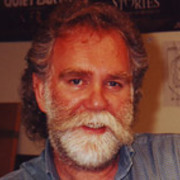
Pat Cox
Pat Cox's filmmaking career crosses the gamut, spanning everything from German fighter pilots to Scottish psychiatrists and New Zealand's most beloved dog.
Although “there was no film industry here virtually in those days”, Cox began working in film in his native Ireland, thanks to a next door neighbour in Dublin who worked as a cameraman, “He asked me one day if I would come on a shoot with him to carry his camera gear and that was it". Soon Cox was developing parallel skills as an editor and cameraman. In the second half of the 1960s he worked in various assisting roles on a number of features shooting in Ireland: among them David Lean romance Ryan's Daughter, and The Blue Max, based on German fighter pilot Bruno Stachel.
Cox met his American wife to be while she was studying in Ireland and moved with her to Nebraska in 1968, and then in 1973, to New Zealand.
Cox spent time as a cameraman (often freelancing for Australian network ABC), editor and production manager. Soon after he set up Film Editing Services, one of New Zealand's earliest independent post production facilities, importing two Steenbeck editing machines.
He had also taken on the "little mini film school" that was running at Wellington Polytechnic, teaching film and TV to graphic design students. Cox said, “some of those people are still in the industry and went on to great success in their own fields”, including future animator Euan Frizzell, and editor Annie Collins (Patu!). Following the course Cox trained Collins as an editor at Film Editing Services and recommended her as an assistant editor for Sleeping Dogs (1977).
The mid 70s saw a big growth in locally-made television advertisements. Many were edited at Cox's premises, with Cox cutting film alongside legendary commercials talents Geoff Dixon and Tony Williams. When Williams shot his first feature Solo, he employed Cox as production manager. With Sleeping Dogs shooting simultaneously, the shortage of available crew meant that many had to be trained up on the job.
Cox also edited films on everything from Turangi to the Boys' Brigade. He would also later co-edit (with Jacqueline Scott) the controversial documentary Birth, with R.D. Laing (1978), in which the Scottish psychiatrist criticised childbirth practices in Western society.
Cox had become a fan of Murray Ball newspaper strip Footrot Flats, finding the strip gave him inroads into the unsure, sometimes inarticulate society that was his new home. Cox said in this Screentalk video interview, “I saw it as this terrific microcosm of life in New Zealand". Deciding that it had the makings of an animated feature, he got Ball's phone number from a newspaper editor, and gave him a call. Initially Ball wasn't interested. A number of phone calls and meetings later, the two began working on a script, later calling in the talents of cartoonist Tom Scott.
Although the Footrot comic strip was a trans-Tasman hit, the path to a movie version took many years. Potential Kiwi funding sources felt that since the project would involve mainly Australian animators, the money should come from across the Tasman. Investors in Australia felt differently, sending Cox back to New Zealand. In the end Cox won funding from newspaper group INL, and joined forces with New Zealand producer John Barnett. Barnett persuaded merchant bankers Fay, Richwhite to underwrite the project.
When Footrot Flats: A Dog's Tale was finally released in 1986, the film (and soundtrack) proved a major local hit. Footrot Flats became the most successful New Zealand feature released on its home turf in the 80s, and is still in the country's all-time local top ten today. It is the only animated feature yet to originate from New Zealand, and is a rare local title to win wide (60 print) Australian release. In September 2011 Cox was a key player in arranging the film's 14-cinema re-release, plus a DVD and Blu-ray release soon after in December.
Cox has sought funding for another dozen scripts over the years, though commercials have provided a far more reliable income. He established company Blick, Tomei, Cox back in 1980, to produce commercials alongside cinematographer/director John Blick and American-born art director Bob Tomei. With a growing roster of directors — and Blick's departure to make ads in America — the company's name was soon changed to Partners Film Company. Eventually consisting of Cox and John Toon, Partners finally wound up in 1990 after a decade of production.
Cox moved directly to become Head of Television Production at Colenso Advertising. He then spent two years with Silverscreen, before joining Saatchi & Saatchi as Head of Production in 1995. During his time at the three companies, he worked on high-profile campaigns for many companies including Steinlager, NZ Post, Air New Zealand, and Mainland Cheese.
Cox left in 2001 to establish The Producer Board. The independent agency offered assistance to both locals and non-locals making commercials downunder. Through the company he produced many more commercials, including a NZ Tourism 100% Pure series, and international campaigns for Mitsubishi and Sony PlayStation. He also kept his hand in animation, with a series of electoral enrolment promotions that were used across four election campaigns.
Pat Cox has worked as a producer on three short films: Paul Middleditch's Where did the White Go (1990), Grant Lahood's multi-awardwinning The Singing Trophy (1992) and Yvette Thomas-directed psychosexual drama The Lost One (2006).
Sources include
Pat Cox
'Pat Cox talks producing' (Video Interview), NZ On Screen Website. Director Clare O’Leary (Uploaded 24 February 2009). Accessed 7 December 2010
'ScreenTalk Legends - Annie Collins' (Video Interview) NZ On Screen website. Director Kathryn Quirk. Loaded 15 August 2024. Accessed 15 August 2024
Lesley Stevens, Footrot Flats The Dog's (Tail) Tale - The Making of the Movie (Lower Hutt: Inprint Limited, 1986)
'Introducing Pat Cox the Producer' The Producer Board Website. Accessed 18 November 2011